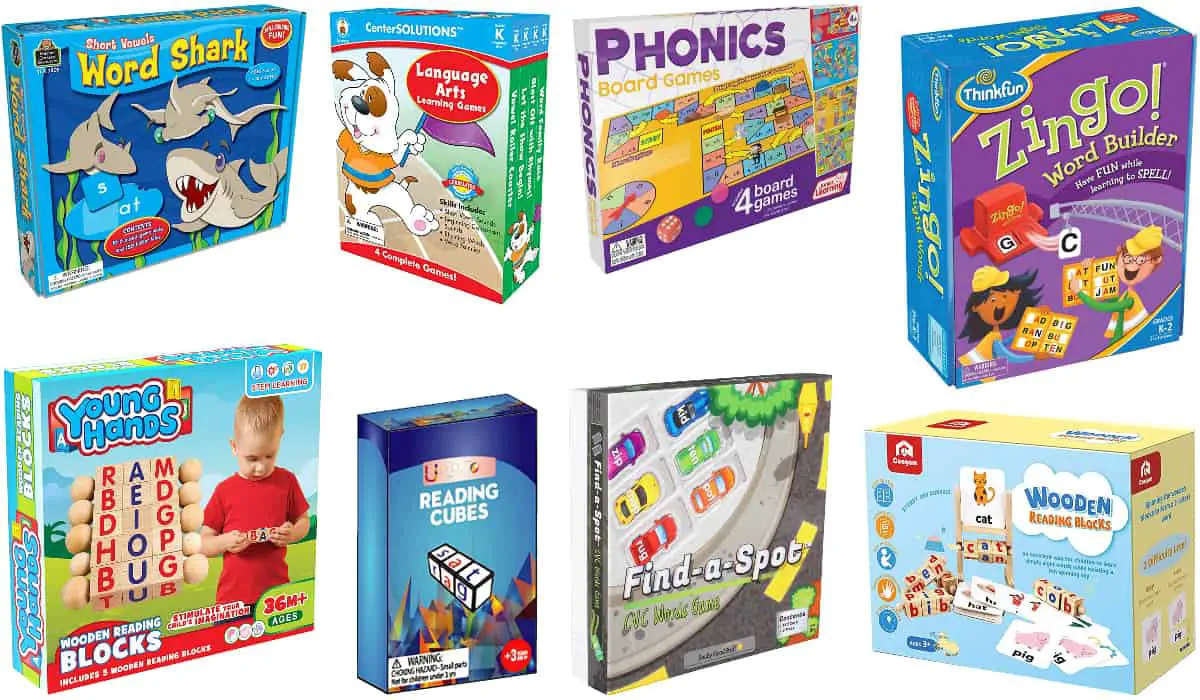This post contains affiliate links.
Learning CVC words is a great step in the reading learning process, as they are simple to decode. So, here are 16 board games and toys to help children become better readers through CVC words.
I found 10 CVC board games and 6 CVC toys – most of the board games are simple roll-and-move games that are easy and quick to play. While the toys are manipulative blocks and objects for independent reading practice.
CVC Board Games and Toys Comparison Table
| Game | Age | Type | Players | Rating |
|---|---|---|---|---|
| Phonics Board Games | 4‑6 | Board | 2‑6 | ★★★★☆ |
| Language Arts Learning Game | 4‑6 | Board | 2-4 | ★★★★☆ |
| Jet-Boat Harbor: Short Vowels Game | 4‑6 | Board | 2‑4 | ★★★★☆ |
| Zingo World Builder | 4‑6 | Bingo | 2‑6 | ★★★★★ |
| Learning Lift-Off | 4‑6 | Board | 2-4 | ★★★★☆ |
| CVC Words Crossword Puzzles | 4-6 | Crossword | 2+ | ★★★★★ |
| CVC Spelling | 4-8 | Board | 2+ | ★★★★★ |
| Word Shark | 4-6 | Crossword | 1+ | ★★★★★ |
| Find-A-Spot | 4-6 | Board | 1+ | ★★★★★ |
| Short Vowel Pattern | 4‑8 | Board | 2+ | ★★★★☆ |
| Wooden Reading Blocks | 4‑6 | Toy | 1+ | ★★★☆☆ |
| Rainbow CVC Objects | 4-6 | Magnets | 1+ | ★★★★★ |
| Reading Cubes | 4‑6 | Rods | 1+ | ★★★☆☆ |
| Wooden Reading Blocks | 4-6 | Rods | 1+ | ★★★★☆ |
| Spin-and-Read Blocks | 4‑6 | Rods | 1+ | ★★★★☆ |
| Wooden Letter Blocks | 4-6 | Rods | 1+ | ★★☆☆☆ |
CVC Board Games
Phonics Board Games (Junior Learning)
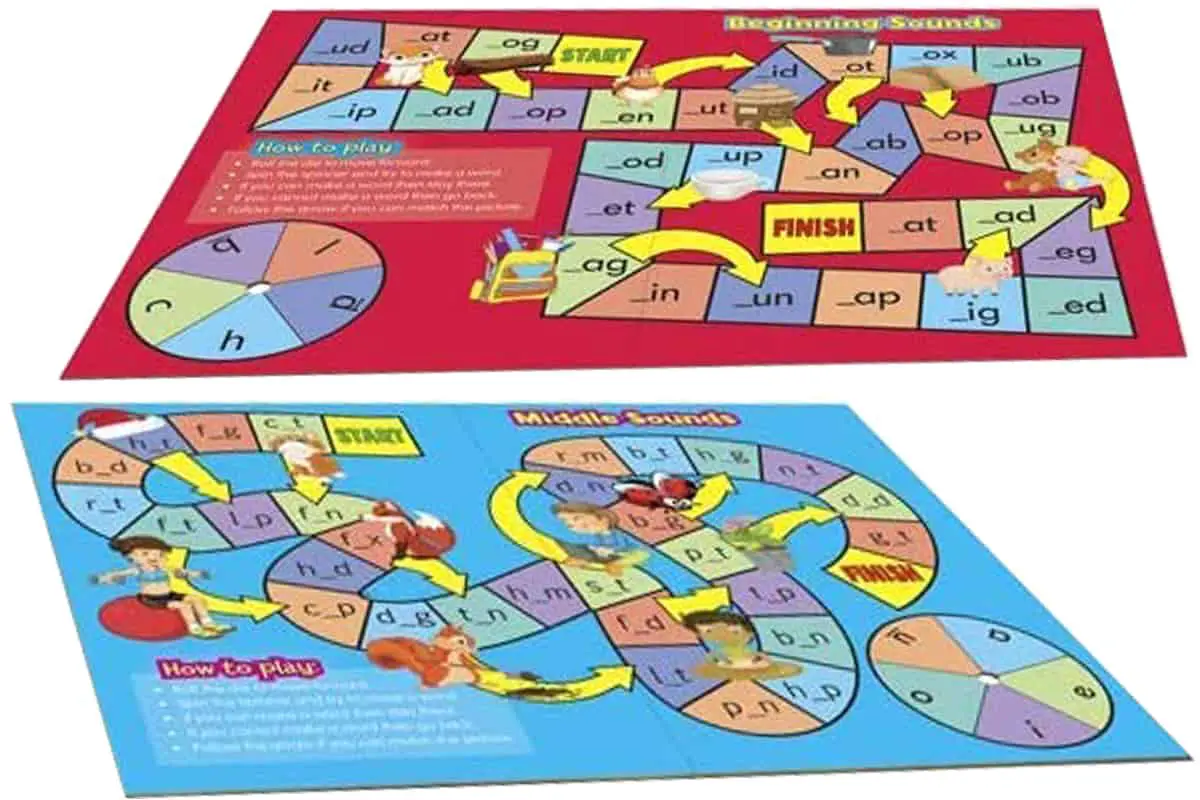
★★★★☆
For Families and Schools | Age 4-6 | 2-6 players | Price $$ | Duration 10-20 min
Phonics Board Games features four different board games about phoneme isolation and blending for your beginning readers. There is a board game for beginning, middle, and ending sounds of CVC words.
features four different board games about phoneme isolation and blending for your beginning readers. There is a board game for beginning, middle, and ending sounds of CVC words.
I like this set of four board games because:
- Each board can accommodate up to 6 players, so it can be used for homes and schools
- It includes an answer key for self-correcting
- Practices phoneme blending and isolation which are necessary skills for beginning readers
- It has four board games that are great for replayability
- It also lets your child practice reading non-words which is an excellent way of assessing their letter-sound knowledge and blending skills
I don’t give this game five stars because there is only one set of die, player pieces, and spinner. So, you will need to get more of those to use this set for larger groups of students.
Language Arts Learning Games (Carson Dellosa Education)

★★★★☆
For Families and Schools | Age 4-6 | 2-6 players | Price $$ | Duration 10-20 min
Language Arts Learning Games includes four complete games that tackle short vowel sounds, beginning sounds, rhyming words, and word families. This set also comes with four boards, 16 game pieces, and four dice.
includes four complete games that tackle short vowel sounds, beginning sounds, rhyming words, and word families. This set also comes with four boards, 16 game pieces, and four dice.
I recommend this set because:
- It allows four players to play in each board so it can be used in homes and schools
- It lets your child practice different skills that are necessary for honing their reading ability
- The board games have individual boxes for easy storage
- The set also includes four pieces for each board game, so you don’t have to buy another set to play with the other board games
- Each board also uses different themes, which is excellent for engagement and replayability
However, I only give this board game four stars because adult supervision is still needed to play the game, especially with the beginning sounds. In addition, some of the words used in that particular board game cannot be decoded by younger players.
Jet-Boat Harbor: Short Vowels Game (Lakeshore Learning)

★★★★☆
For Families | Age 4-6 | 2-6 players | Price $$ | Duration 10-20 min
Jet-Boat Harbor: Short Vowels Game lets your child practice their reading skills as they speed through a harbor to look for short vowels. This game comes with:
lets your child practice their reading skills as they speed through a harbor to look for short vowels. This game comes with:
- 50 vowel tiles
- 4 game cards
- 4 player pieces
- 1 die
This board game is easy and fun to play. A player wins the game when they build all the words in their cards before others do. The board is also pretty unique as there are four entry points, and the players will go around it as they try to find their vowels. I like this game because it challenges your child in matching the vowel to the incomplete word to form a complete one.
However, you will have to supervise your child when playing this game. This is because there are instructions on the board that they will not be able to read.
Zingo Word Builder (ThinkFun)
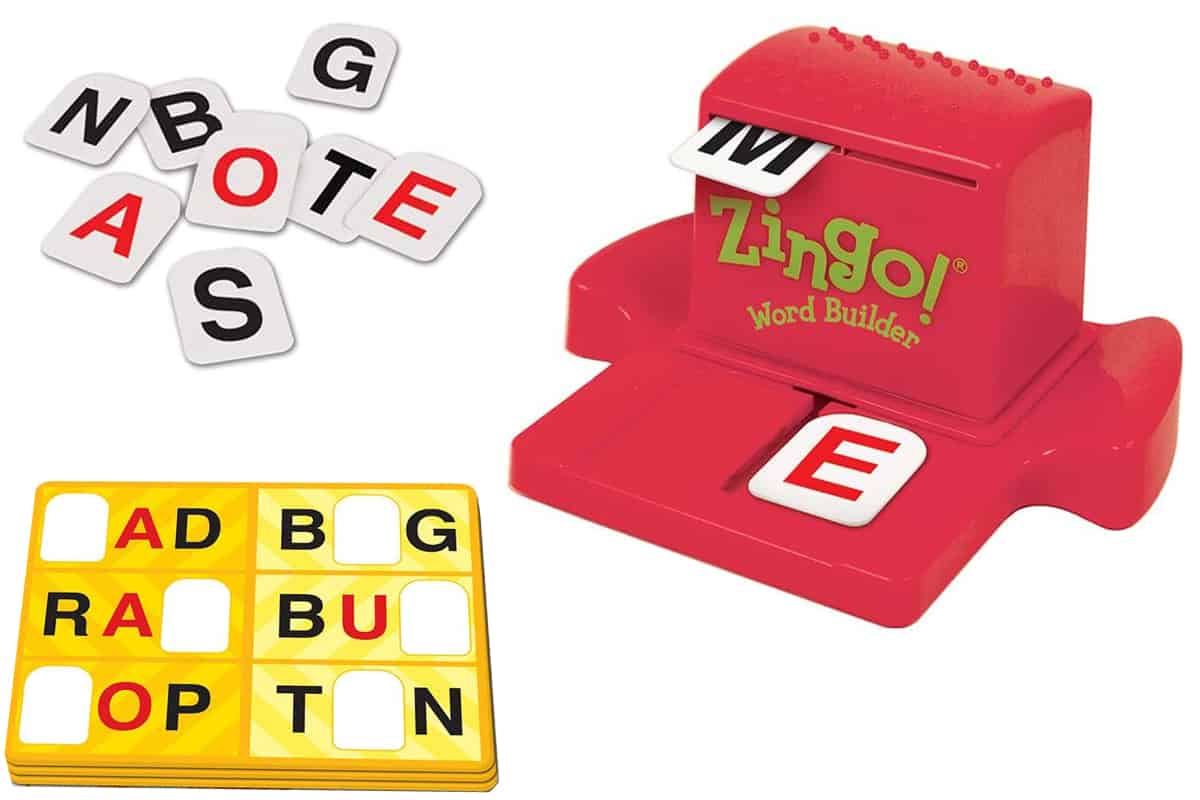
★★★★★
For Families | Age 4-6 | 2-6 players | Price $$ | Duration 10-20 min
Zingo Word Builder is a “bingo-inspired” game where players race to fill their board before the others do. Each set comes with one Zinger, 72 letter tiles, 6 double-sided Zingo! Cards.
is a “bingo-inspired” game where players race to fill their board before the others do. Each set comes with one Zinger, 72 letter tiles, 6 double-sided Zingo! Cards.
This game is very easy to play. Your child only needs to follow three steps:
- Slide the Zinger.
- Take the letter before their opponent does.
- Fill their card to win.
Each side of the board has six words and two levels of gameplay. One side has one missing letter, while the other has two missing letters for more advanced players. I like this game because:
- it develops both reading and fine motor skills as children slide the Zinger and pick up letters
- it has color-coded letters that help beginning readers identify consonants from vowels
- it has two levels of gameplay to match your child’s reading and spelling skills
- there are no pictures near the words, so it is totally up to your child’s ability to match a letter to complete a word
- it enhances vocabulary as there are so many words that they can create just by switching letters
I think this is really a five-star purchase because even though there are only six words on each board, there are still plenty of words to create just by switching letters.
Learning Lift-Off (Didax Educational Resources)
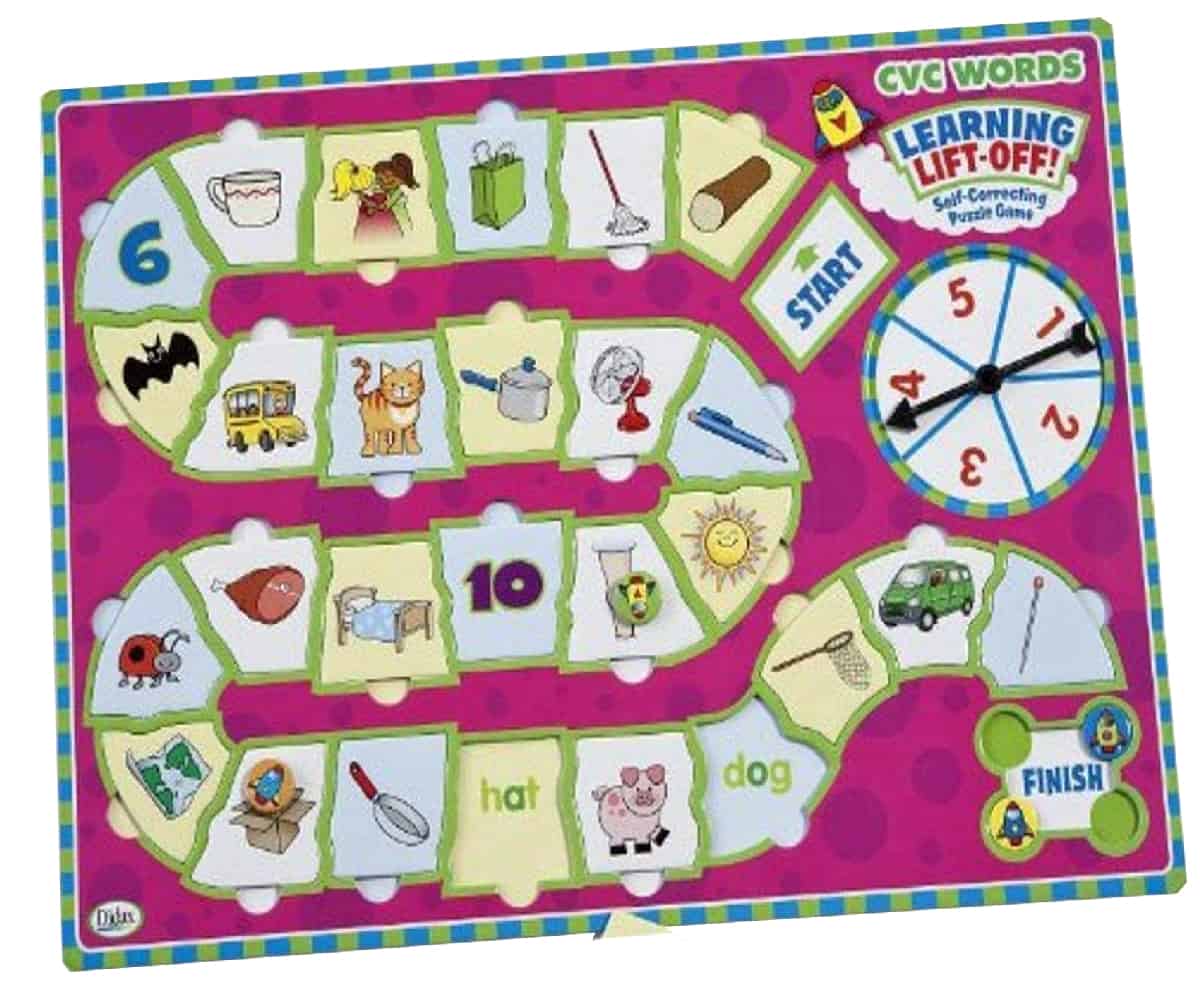
★★★★☆
For Families | Age 4-6 | 2-4 players | Price $$ | Duration 10-20 min
Learning Lift-Off is a simple roll-and-move CVC game that helps your child practice phoneme segmentation and blending. All pieces – tokens and spinner – are integrated into the board for easy storage.
is a simple roll-and-move CVC game that helps your child practice phoneme segmentation and blending. All pieces – tokens and spinner – are integrated into the board for easy storage.
Depending on what reading skill you want to focus on, you can use this board game for it. Here are some examples:
- For phoneme segmentation – keep the pictures on the board. Have your child name the image, then segment the sounds during their turn
- For phoneme blending – remove the photos and have your child read the words during their turn
- For matching – you can also remove the pictures and have your child read the word on the board, then match the image during their turn
I like this game because you can use it to teach specific phonemic awareness skills. It is easy to store because the player pieces can be put back on the board to avoid losing them after every use. It also develops your child’s fine motor skills as they remove and put the pieces in place. While this is a positive aspect of the game, it can also be a problem for some children because the pieces are small.
CVC Words Crossword Puzzles (Lakeshore Learning)
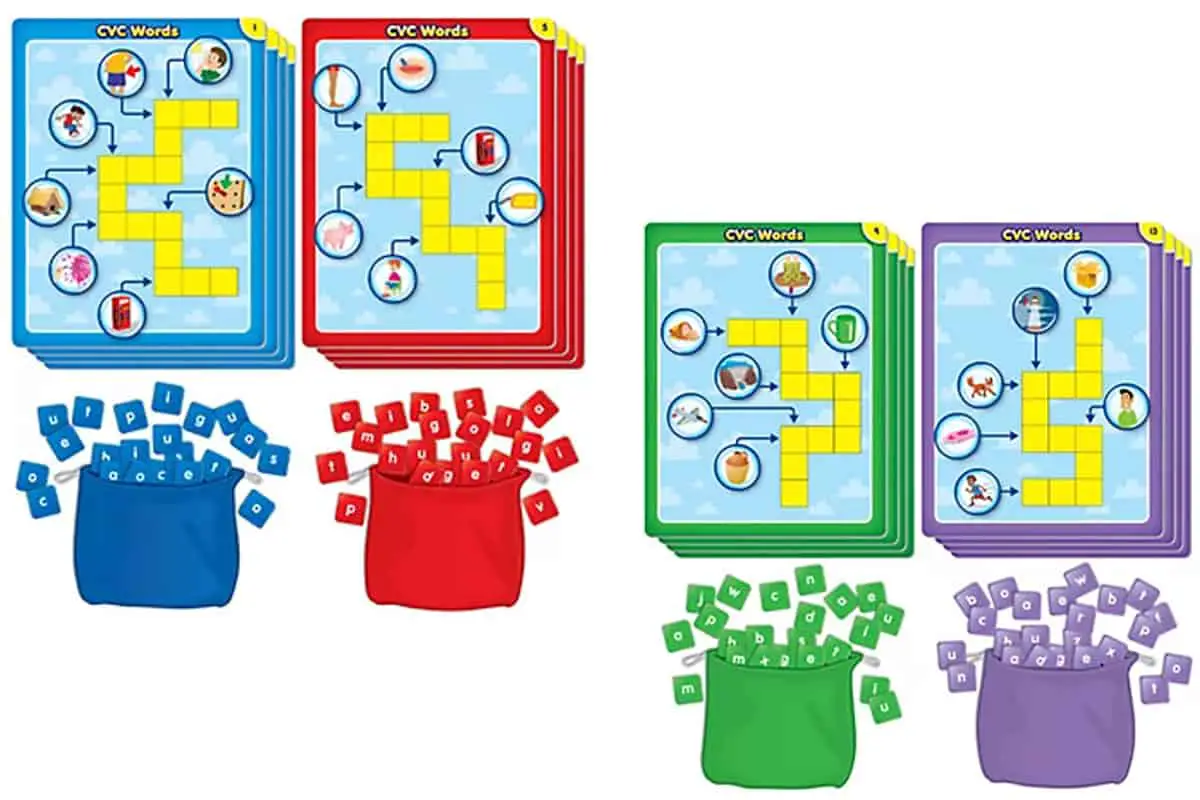
★★★★★
For Families and Schools | Age 4-6 | 2+players | Price $$$ | Duration 10-20 min
Lakeshore Learning’s CVC Words Crossword Puzzles are a fun and engaging way to practice reading and spelling CVC words. Each box comes with 16 crossword puzzles, 114 plastic tiles, 4 drawstring bags, and an answer card.
are a fun and engaging way to practice reading and spelling CVC words. Each box comes with 16 crossword puzzles, 114 plastic tiles, 4 drawstring bags, and an answer card.
I like this set because:
- There are 16 boards with different puzzles, which is excellent for replayability
- Each board also has its color-coded letters and bags for easy storage and organization
- More than four players can play at once if used in pairs or groups
I give this game five stars because I believe it’s an excellent buy for a low price. However, you cannot use multiple same-colored boards in one game because there are few letter tiles.
CVC Spelling (Smart Kids)
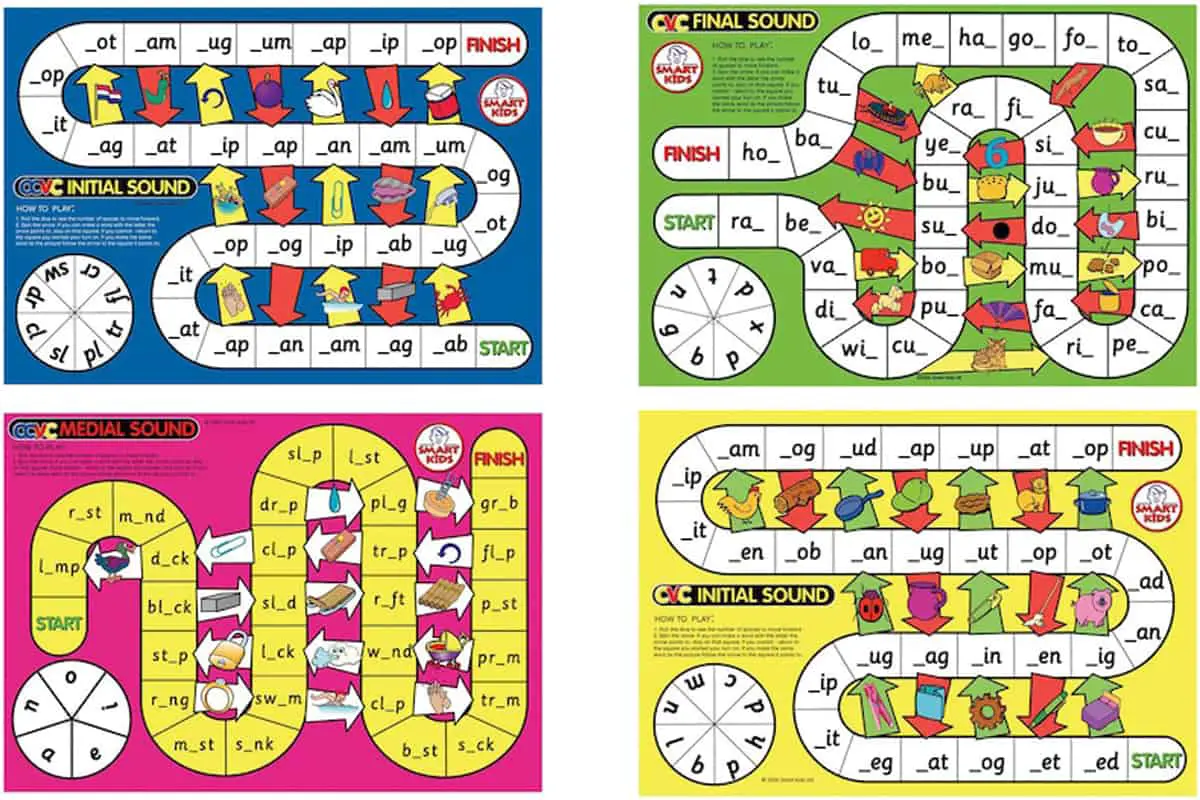
★★★★★
For Families and Schools | Age 4-6 | 2+players | Price $$$$ | Duration 10-20 min
CVC Spelling is a great game for teaching your child three-letter short vowel words and beginning and ending consonant blends. It comes with 6 games that tackle specific skills:
is a great game for teaching your child three-letter short vowel words and beginning and ending consonant blends. It comes with 6 games that tackle specific skills:
- CVC Initial phonemes
- CVC medial phonemes
- CVC ending phonemes
- CCVC initial phonemes
- CCVC medial phonemes
- CVCC ending phonemes
This game comes with 20 game pieces, spinners, a die, and an answer sheet. So, you can use all the board games at once and accommodate up to 20 players. However, you may need to buy more dice because there is only one in the box. This game is easy to play. You only need to:
- Roll the die and move your piece
- Spin the spinner and try to make a word with the letter/s you land on and the word on the board
- Stay in the space if you can make a word.
You can use these games to practice phoneme isolation, segmentation, and blending, so it is perfect for beginning readers at homes or schools!
Word Shark: Short Vowels (Teacher-Created Resources)

★★★★★
For Families and Schools | Age 4-6 | 1+players | Price $$$$ | Duration 10-20 min
Word Shark: Short Vowels is a set of games that help your child practice their phonemic awareness skills. It comes with 10 double-sided boards and 150 letter tiles – 58 vowels and 92 consonants.
is a set of games that help your child practice their phonemic awareness skills. It comes with 10 double-sided boards and 150 letter tiles – 58 vowels and 92 consonants.
There are different ways to play this game. Some of your options are:
- Use the “shark side” and start filling the word chunks to make a word
- Use the blank “ocean side” to create as many words as you can
I recommend this game for homes and classrooms because 10 students can play at a time. It encourages players to think critically as they make a match on the shark side. It also widens their vocabulary as they try to spell as many CVC words as they can with other children. The two different sides are also great for differentiated learning.
Find-A-Spot ™ (Really Good Stuff)
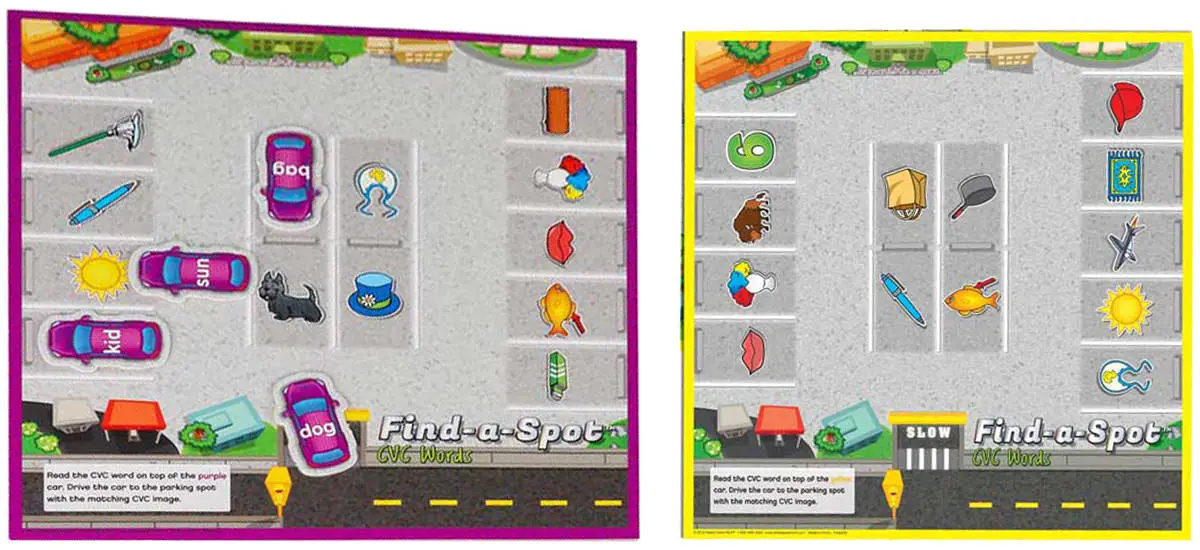
★★★★★
For Families and Schools | Age 4-6 | 1+players | Price $$$$ | Duration 10-20 min
Find-A-Spot ™ is a fun reading game where players park their cars into a matching parking spot. This set comes with 6 double-sided game boards and 180 color-coded cards.
™ is a fun reading game where players park their cars into a matching parking spot. This set comes with 6 double-sided game boards and 180 color-coded cards.
This game reinforces blending and word recognition skills. And I like this game because:
- It has easy-to-follow instructions that you can read on each board
- It allows for self-checking as the correct match is printed on the underside of the cars
- It has color-coded cars and parks for easy game setup
- It practices matching skills
You can also use this set for homes and schools because it has six boards to accommodate many players.
Short Vowel Pattern: Word Building Board Games (Really Good Stuff)

★★★★☆
For Families and Schools | Age 4-8 | 2-12 players | Price $$$ | Duration 10-20 min
Short Vowel Pattern: Word Building Board Games is a set of board games that focuses on beginning and ending consonants and middle sounds of CVC, CCVC, and CVCC. Each box comes with 6 game boards and 12 player pieces.
is a set of board games that focuses on beginning and ending consonants and middle sounds of CVC, CCVC, and CVCC. Each box comes with 6 game boards and 12 player pieces.
To play the game, players only need to spin the wheel then match it with a chunk that they can make into a word. The board has ladders and slides that let children move forward or backward in the game board. I think this is a good CVC board game because:
- It reinforces phoneme isolation and blending of CVC, CCVC, and CVCC words
- It is fun and easy to play
- It can be played by 12 or more children if you add more tokens to the game
This game can be an excellent addition to schools and homes.
CVC Toys
Wooden Reading Blocks (Coogam)
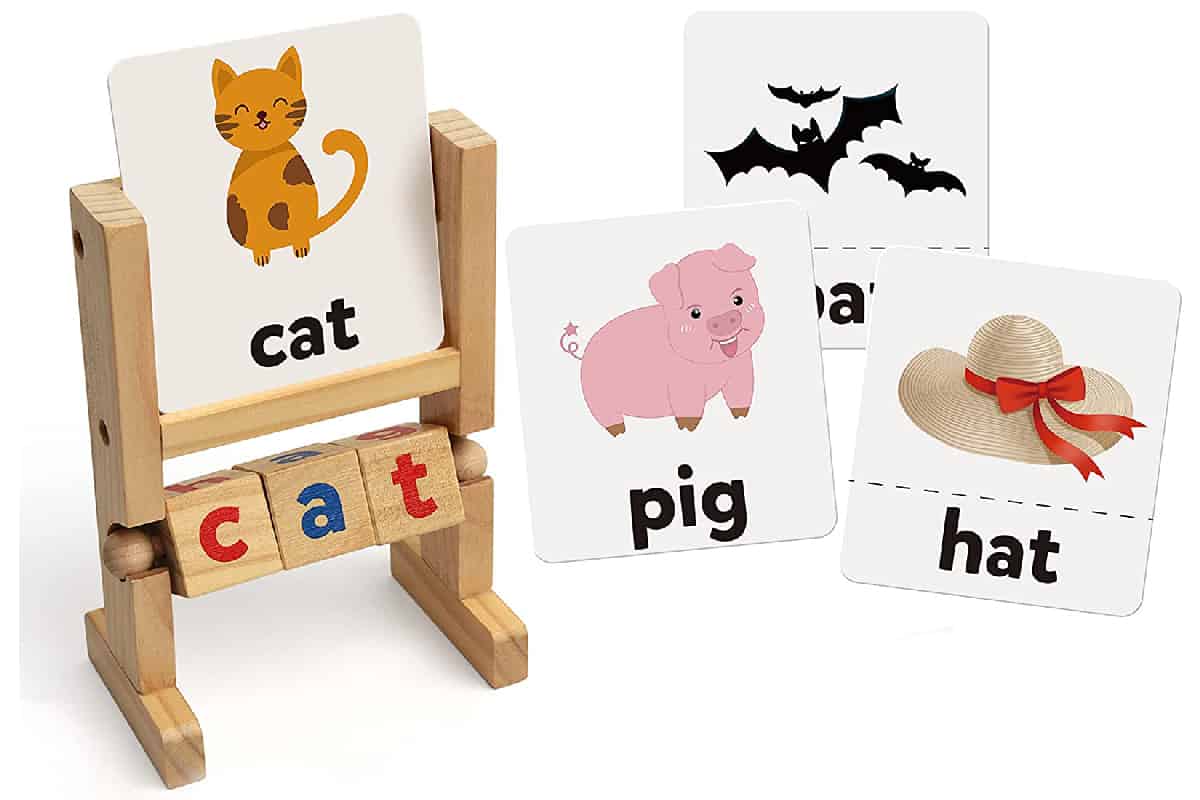
★★★☆☆
For Families | Age 4-6 | 1+ players | Price $$ | Duration 10-20 min
Wooden Reading Blocks is a rotating letter puzzle that reinforces phoneme segmentation and blending. It comes with 2 sets of flashcards – one with picture and label and another with pictures only, 5 rods with CVC letters, and a wooden tray.
is a rotating letter puzzle that reinforces phoneme segmentation and blending. It comes with 2 sets of flashcards – one with picture and label and another with pictures only, 5 rods with CVC letters, and a wooden tray.
I like this toy set because you can use it to introduce and practice phonemic awareness skills. Here are some ways to use it:
- For readers who have just mastered their alphabet sounds, you may use the pictures with labels and have them match the letters. This way, they understand how three sounds blended together to make a word.
- For more confident beginning readers, you can use the pictures and have them sound out and spell the word that matches the picture
- For reading practice, just have your child spin the blocks and read whatever CVC combination they make
It is equally important to read non-words because it lets you assess your child’s blending skills. This toy is excellent for honing fine motor skills.
However, I give this game only three stars because it has low replayability when used with the cards.
Rainbow CVC Objects (Junior Learning)
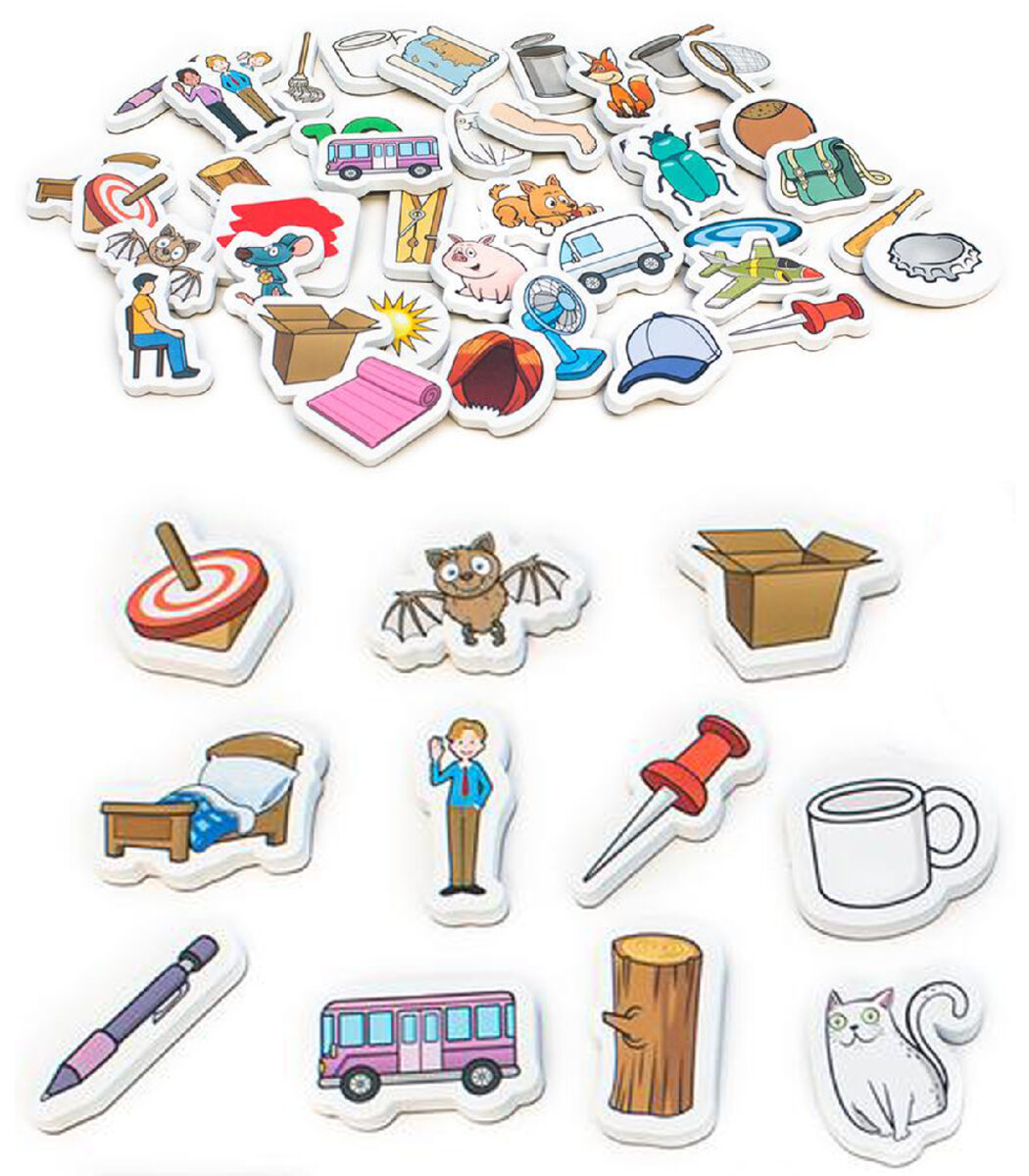
★★★★★
For Families and Schools | Age 4-6 | 1+players | Price $$$$ | Duration 10-20 min
Rainbow CVC Objects is a set of 40 magnetic objects that can be spelled with the CVC pattern. Because it is not labeled, it is a great tool for practicing phonemic awareness skills.
is a set of 40 magnetic objects that can be spelled with the CVC pattern. Because it is not labeled, it is a great tool for practicing phonemic awareness skills.
I like this set because you can use it to teach:
- Phoneme identification of beginning, middle, and ending sounds
- Phoneme segmentation
- Phoneme blending
- Rhyming
Some children rely heavily on words to identify phonemes, so using these objects will help assess their abilities. You can also have your child sort these objects according to short vowel sounds or match rhyming CVC words.
Reading Cubes (Uplay Toys)
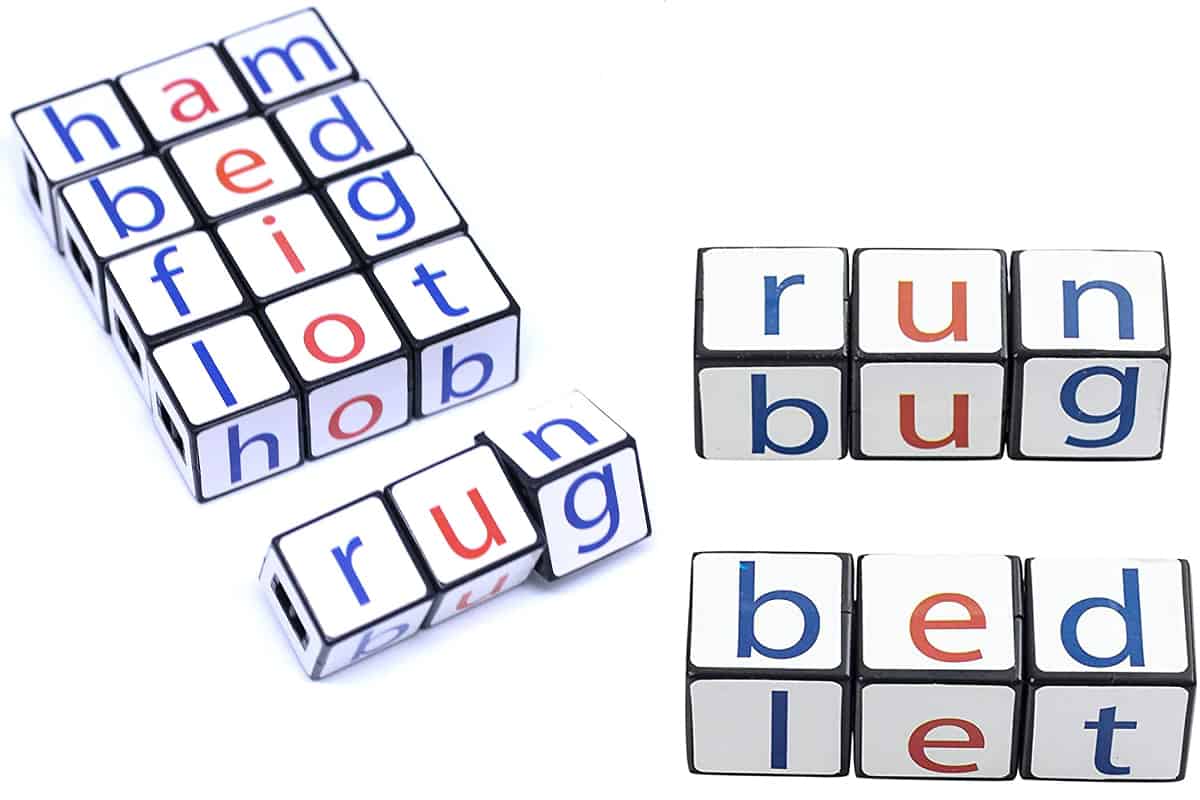
★★★☆☆
For Families | Age 4-6 | 1+ players | Price $$ | Duration 10-20 min
Reading Cubes is another manipulative that you can use to practice blending with your child. This set comes with five rods with three blocks that can form 80 CVC words.
is another manipulative that you can use to practice blending with your child. This set comes with five rods with three blocks that can form 80 CVC words.
The letters are in the cubes are color-coded – blue for consonants and red for vowels. I think this can be a good practice toy for reading CVC words and non-words. It also develops the fine motor skills of children. While it can be used at school for learning centers, it is best for homes because the cubes are made of plastics and are not durable for multiple uses.
This is a three-star toy only because the cubes are too small. So, some children may find it difficult to manipulate them. In addition, they may be at risk of breaking them after several uses.
Wooden Reading Blocks (Young Hands)
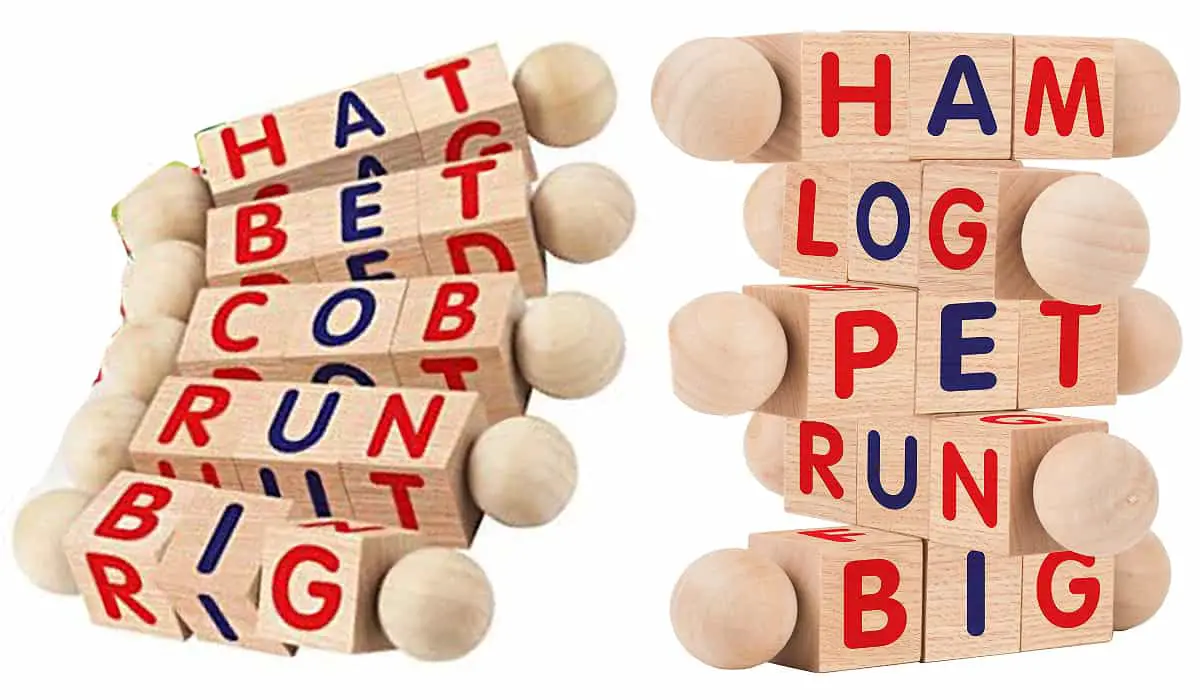
★★★★☆
For Families and Schools | Age 4-6 | 1+ players | Price $$ | Duration 10-20 min
Wooden Reading Blocks features a set of five spinning rods that represents the five short vowel sounds. You can use this set to teach letter and word recognition, blending, and phoneme segmentation.
features a set of five spinning rods that represents the five short vowel sounds. You can use this set to teach letter and word recognition, blending, and phoneme segmentation.
I like this set because:
- it is made of sturdy materials, which are great for young children and multiple uses.
- It has color-coded letters for easy recognition for beginning readers
- Your child can also practice reading words and non-words to hone their skills and widen their vocabulary
- The blocks are big, so they are easy to use for children
- It develops fine motor skills
The older version uses italicized letters which children may find difficult to recognize. However, newer ones have been made with capital letters and block fonts that are more familiar to beginning readers.
Spin-and-Read Blocks (Little Bud Kids)
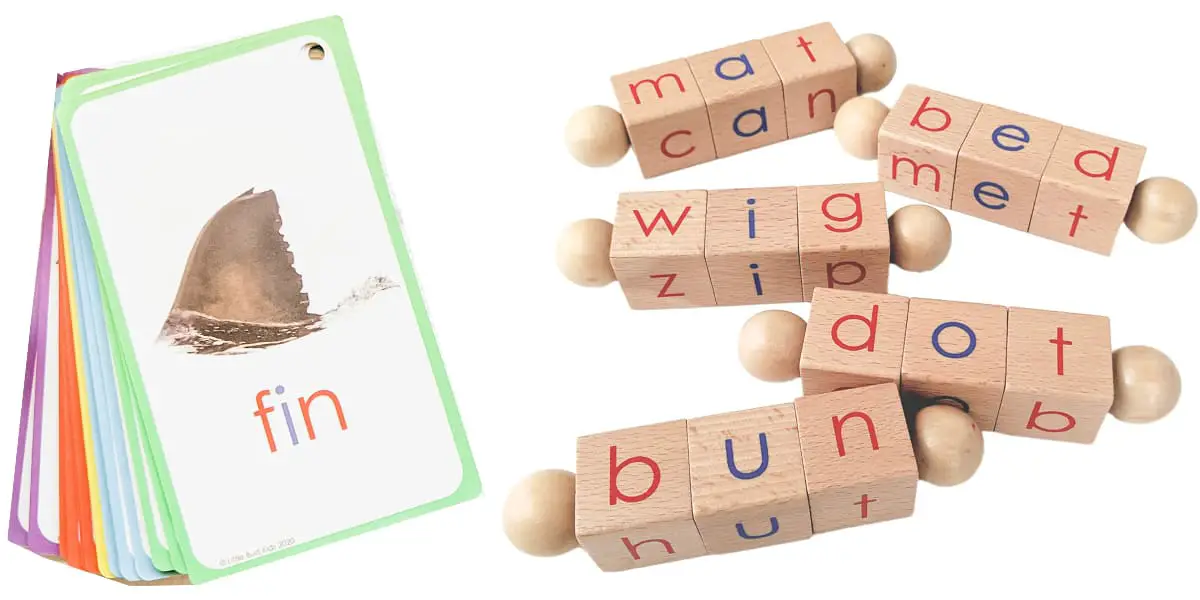
★★★★☆
For Families and Schools | Age 4-6 | 1+ players | Price $$$ | Duration 10-20 min
Spin-and-Read Blocks is a manipulative toy for learning how to read and spell CVC words. It comes with five rotating rods and 30 double-sided flashcards.
is a manipulative toy for learning how to read and spell CVC words. It comes with five rotating rods and 30 double-sided flashcards.
This toy helps reinforce phonemic awareness skills and word recognition. Your child can twist and turn the blocks to form words and non-words for blending practice. You can also let them use the flashcards for phoneme identification and segmentation.
I like these reading blocks because:
- It uses a simple typeface that is easily recognizable by children
- It has color-coded letters for consonants and vowels
- the flashcards have two sides, with one showing the correct spelling of words for self-correction
- it can be used to create dozens of CVC words
While this can be a great buy, I’m still giving it 3 stars because it has low replayability if frequently used with the flashcards.
Wooden Letter Blocks (Seanmi)

★★☆☆☆
For Families and Schools | Age 4-6 | 1+ players | Price $$$ | Duration 10-20 min
Seanmi’s Wooden Letter Blocks is a rotating letter puzzle for learning how to identify, segment, and blend phonemes. It comes with one rod per short vowel sounds.
is a rotating letter puzzle for learning how to identify, segment, and blend phonemes. It comes with one rod per short vowel sounds.
Like the other letter blocks in this list, this toy helps develop your child’s phonemic awareness. It is also made of wood, so it is durable and perfect for multiple uses. It also reinforces letter and word recognition while also honing your child’s fine motor skills.
Children may find it challenging to identify the letter because they are italicized. So, I don’t really recommend this for beginning readers who are already struggling with their letters.
Other Fun Board Games and Toys for Beginning Readers
A lot of children struggle to master phonemic awareness skills like phoneme isolation and blending. So, we need other methods besides flashcards and books to lessen that struggle and make reading more exciting for them. That is why I believe incorporating games in reading practices encourages your child to be eager to learn about this skill. So, check out these posts to find more board games and toys for beginning readers:
- 10 Rhyme Board Games and Toys for Preschoolers and Primary School

- 8 Rhyme Bingo Games for Schools and Families

- 6 Rhyme Dice & Rods Games for Preschoolers and Primary School

- 13 Rhyme Card, Puzzle & Domino Games for Primary & Preschool Children

Edudingo.com is a participant in the Amazon Services LLC Associates Program, an affiliate advertising program designed to provide a means for sites to earn advertising fees by advertising and linking to Amazon.com. We also participate in other affiliate programs which compensate us for referring traffic.

